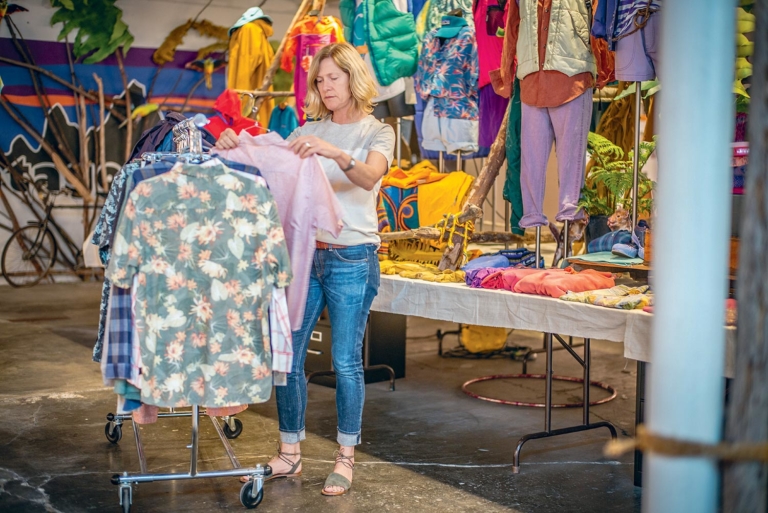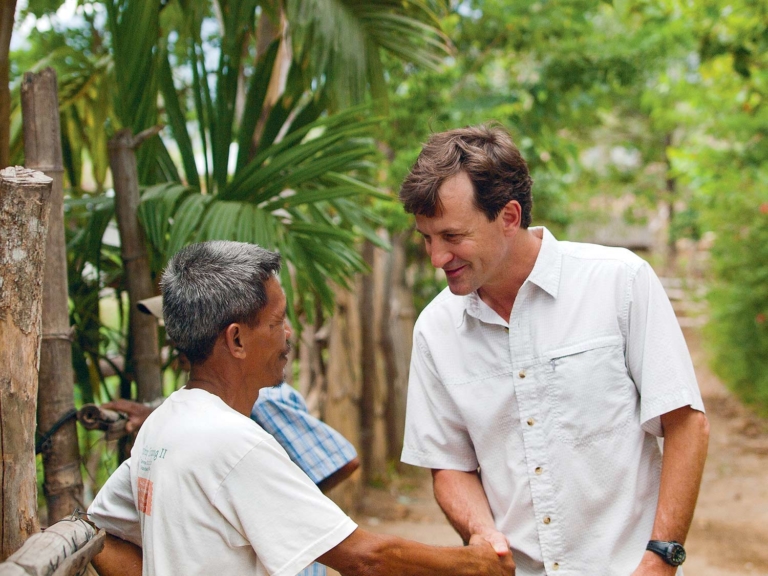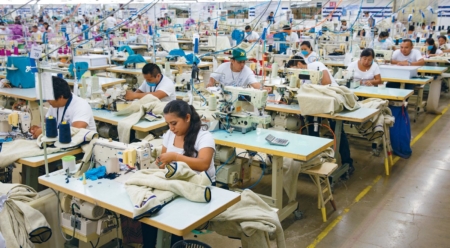Partnering with the People Who Make Our Clothing, with Fair Trade Practices
We started developing our social responsibility program in the mid-1990s, working side by side with factory partners. In 2001, we became a founding member of the Fair Labor Association, a nonprofit that works to improve working conditions worldwide.
With over a decade of close focus on our cut-and-sew factories, in 2011, we moved one link back in the supply chain to audit labor practices in the mills that make our fabrics. After joining Fair Trade USA’s apparel program in 2014—an effort that required us to change our internal procedures and work across many departments to embed the Fair Trade principles—we launched a successful pilot of 10 Fair Trade styles in the fall of that year.
This year marks a giant step forward as we grow our Fair Trade numbers to 480 styles and 14 factories. The effort has been worthwhile because now 15,700 factory workers are directly benefiting from every Patagonia Fair Trade purchase, and the factories we work with can scale their Fair Trade production when other brands sign on.

Helena Barbour, Patagonia’s Vice President of Global Sportswear. Photo: Tim Davis
How Fair Trade Makes an Impact
Helena Barbour, Patagonia’s Vice President of Global Sportswear, is one of the driving forces behind the Fair Trade USA (FTUSA) partnership and the ongoing initiative to steadily increase the number of Fair Trade products at Patagonia. We spoke with her to get some insight into the early steps she took to usher in this company-wide change.
Why did you want to create a Fair Trade apparel line?
In early 2014, I visited several factories in Sri Lanka with our production team. It reminded me that although we purchase clothes based on fabric and fit in the store, the people who make our clothes are a huge part of the equation and are often forgotten. Most people—including myself—know very little about the people who make their clothing.
I came back wanting to do something, and after a colleague mentioned Fair Trade USA were in the early stages of partnering with apparel companies, was hopeful that this could be a tangible solution to empowering workers and recognizing them.
FTUSA has long been associated with coffee and chocolate and already had programs in place. They provided the link between what I saw in the factories and how we could make further improvements. And in terms of the opportunity to scale, I knew that we could use the sportswear product line to amplify the really good work our Social Responsibility team was already doing in our factories.
FTUSA has also spent decades working to fight poverty in the nonprofit sector and has learned through experience what motivates and inspires workers. One of the most empowering aspects of the FTUSA program is that a brand pays a premium to a workers fund, and through a democratic process, workers decide how to spend the money. By making workers central figures in financial decision-making, it creates a true sense of partnership.
Because we were able to work with FTUSA, everything happened quite quickly and it was a matter of months before we had a program in place. We were able to launch 10 styles in June, 2014.
What happened next?
We weren’t sure what to expect, but early on we realized the benefits extended way beyond just paying premiums directly to workers. It opened up constructive dialogue between workers and management, and engaged workers directly in making collective decisions about how to use premiums.
Still, it was not a clear path, especially since we were the first apparel company to dramatically scale Fair Trade across multiple factories and regions. The concept seemed like a win-win for the factory and workers so it was hard to anticipate some of the trepidation expressed by factory owners. Their questions made us look even harder at the Fair Trade program and actually helped us gain more confidence in the work we were about to do.
Sometimes the factory owners would ask, “Why don’t you just pay us more and we’ll pay workers more?” But having a third party like Fair Trade USA monitoring the program was important. We can’t just say to our customers, “We’re doing the right thing,” and expect them to blindly trust us. But those early rough patches ended up opening up many dialogues between workers and managers, which in itself was another type of success.
How did workers choose to use the Fair Trade premiums?
For me, that was when the program really came alive. We have seen the premiums used in a variety of ways, from water filters in every workers home to a cash bonus at the end of the year. But what was surprising was that it wasn’t always an obvious benefit that served the majority.
For example, in Sri Lanka the workers voted on a daycare center, which serves mothers and fathers with young children in the factory. While not every worker will benefit from this directly, as a whole, the workforce felt it was worthwhile to have a program that helped parents maintain their jobs, which in the end, benefits everyone at the factory. The way the premiums are used take on the character of the people participating in the program. It’s not a cookie-cutter solution, which is a really great thing.
What are some of the broader implications of Fair Trade?
Again, it goes back to recognizing the people who make our apparel. Brands have a lot of power. Factory workers don’t. Being able to work in safe conditions and to have a voice in the workplace is hugely empowering. Also, the majority of factory workers are women, and every woman deserves the right to feel financially empowered. Fair Trade is one of several programs we are using to meet and elevate our commitment to social responsibility.
What would you say to someone who doesn’t know anything about Fair Trade?
Of course most people recognize that their clothing is made out of materials, but it’s important to understand that it’s also made by hands. And the people who make our clothing deserve to be seen and recognized. Fair Trade is one way to achieve that goal. It’s so much more than just paying premiums to workers. It positively affects workers lives, but also factories, brands and customers who get to make informed choices. It’s about a journey together to change the way we think about our clothing and the people behind it.

Paul Rice (right), Fair Trade USA’s President and CEO. Photo: Paul Rice Collection
Creating a More Equitable Global Economy
Since launching Fair Trade USA in 1998 (in a one-room converted warehouse in Oakland, California), Paul Rice has helped build a vibrant global movement to change the way goods are produced, traded and consumed. We spoke with him about his early steps with Fair Trade USA and his goals for the future.
Why is there a need for Fair Trade products?
First, we need to take a step back and look at the bigger picture. Globalization is already happening. The lowering of trade barriers over the last 20 or 30 years has led to a dramatic increase of trade, and with that, economic growth. Unfortunately, the benefits of globalization are not trickling down to the world’s poorest people. Literally billions of people are being left behind.
How does Fair Trade help with that?
In addition to creating rigorous social, environmental and economic standards to improve working conditions and protect the environment, we’re using a market-based approach that uses the power of companies and consumers to create sustainable solutions to some really challenging problems.
How did you get started in Fair Trade?
I got started fresh out of college. I wanted to be involved in international development, so in 1983 I bought a one-way ticket to Nicaragua to work with farmers. I worked on several well-intentioned projects funded by international aid that aimed to alleviate poverty. They were all top-down, charity-driven programs. All of them failed. I developed a belief that they failed because we didn’t figure out how to develop the farmers’ own capacity to solve their own problems. The farmers didn’t want our charity. They just wanted a decent return for all their hard work.
What was your “light bulb” moment?
I was pretty disillusioned with charity work and was about to bail and head back to the U.S. Then around 1990 I heard about these crazy people in Europe called “Fair Traders.” They were offering a dramatically higher price if we could just get our coffee farmers organized and sell directly to them. It was such a simple, powerful concept based on trade, not aid, and a fair price for a great product. I got 24 braves souls to sign up. We went from getting ten cents to $1.26 for a pound of coffee.
Soon we had over 3,000 families signed up. It was a transformational moment for me. I realized that we could use the market as a powerful force for good. In essence, a new model for capitalism. All of a sudden families were able to eat three times a day instead of two times a day. Schools were being built. There was also an increase of hope, pride and self-confidence—what I call the “invisible dividends.”
Can you explain how Fair Trade works?
One of the most important aspects of the Fair Trade movement is that we go beyond social auditing and compliance. We know that model is broken. An outside auditor coming into a factory doesn’t really understand what’s going on. We know problems are still there and this approach doesn’t do enough. There’s a role for it, but it’s not enough.
That’s why we provide workers and management with compliance training so everyone knows their rights and can be involved in enforcing standards. Beyond that there needs to be some type of incentive to do the work and become a Fair Trade factory. That’s where premiums come in. It’s a way to address the deepest problems, while also rewarding responsible production.
For every Fair Trade Certified™ product sold, the company pays an additional premium that goes directly into a worker-managed account. The workers decide how to spend every dollar, based on what their greatest needs are. It could be scholarships, community projects or medical care. They can also vote to take the premium as a cash bonus.
When did you start offering Fair Trade certification in the apparel Industry?
We spent several years developing a certification model specific to the apparel industry, and then officially launched in 2010. Even though the factory program is different from our roots in agriculture, the basic premise remains the same: If you buy a Fair Trade product, you can reach halfway across the world and help a family create a better life for themselves and their community.
What have you learned about your approach to businesses?
I’m a mission-driven guy and I’ve found a lot of like-minded mission-driven leaders in corporate America. More often than not Fair Trade appeals to the values of executives, but unfortunately some, but not all, have had to check their values at the door. I spend a lot of time taking CEOs to the places where products are made, to show them the true power that their company and their customers have to transform lives. This experience is always a game changer.
How does the customer fit into all of this?
This whole thing hinges on customers purchasing products, whether it’s a chocolate bar or a fleece sweater. We’re essentially asking them to be our allies. They are at the heart of our theory of change. Just like Fair Trade premiums are empowering in communities, the purchasing act is also empowering. Conscience consumers have the power to affect change, especially when they feel like the government isn’t serving their interests in a particular area.
Where do you think all of this is heading?
I see a new model of globalization that’s emerging and growing very rapidly. Fair Trade proves that you can eliminate the conflict between profitability and sustainability. If we can combine this idea of doing the right thing and supporting company profitability, then we’ve hitched ourselves to the most powerful force around.
This story first appeared in the October 2017 Patagonia catalog.
Visit patagonia.com/fairtradeclothing to see the entire collection.

